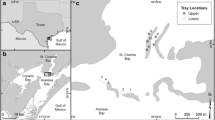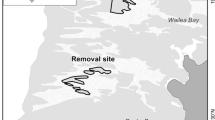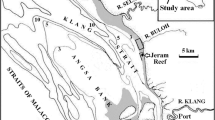Abstract
The habitats utilized by small juvenile (<40 mm carapace length, CL) lobsters (Homarus americanus) are poorly known. We discovered and studied an undescribed juvenile lobster habitat in Nauset Marsh, Cape Cod. Juvenile lobsters (X=26.7 mm carapace length, 6 to 72 mm, n=38) were collected from suction samples primarily 0144 01 in “peat reef” habitats during the period from August 1985 through October 1986. The reefs consisted of large blocks ofSpartina alterniflora peat that had separated from the marsh surface and fallen into adjacent subtidal marsh channels. The smallest lobsters (6 to 7 mm CL) were collected from peat reefs in October 1985, and April and July 1986. In these habitats, juvenile lobster density averaged 2.5 individuals m−2 (range 0–5.7) in suction samples. Peat reef habitats occur in other salt marshes in the northeastern United States and may be an important nursery habitat for small juvenile lobsters.
Similar content being viewed by others
Literature cited
Barshaw, D. E. 1987. The substrate-related behavior and predator-prey interactions of the early juvenile lobster,Homarus americanus. Ph.D. Dissertation, Boston Univ.
Bernstein, B. B., and A. Campbell. 1983. Contribution to the development of methodology for sampling and tagging small juvenile lobsters,Homarus americanus. Can. MS Rept. Fish Aquat. Sci. No. 1741. 34 p.
Botero, L., andJ. Atema. 1982. Behavior and substrate selection during larval settling in the lobster,Homarus americanus.J. Crustacean Biol. 2:59–69.
Chapman, V. J. 1960. Salt Marshes and Salt Deserts of the World. Interscience Publ., Inc., New York. 392 p.
Cobb, J. S. 1971. The shelter-related behavior of the American lobster,Homarus americanus.Ecology 52:108–115.
Cobb, J. S. 1986. Summary of Session 6: Ecology of population structure, p. 2389–2390.In International Workshop on Lobster Recruitment.Can. J. Fish. Aquat. Sci. 43:2064-2402.
Cobb, J. S., andB. F. Phillips (eds.). 1980. The Biology and Management of Lobsters. Vol. 1. Physiology and Behavior. Vol. II. Ecology and Management. Academic Press, New York.
Cobb, J. S., D. Wang, R. A. Richards, and M. J. Fogarty. 1986. Competition among lobsters and crabs and its possible effects in Narragansett Bay, Rhode Island, p. 282–290.In G. S. Jamieson and N. Bourne (eds.), North Pacific Workshop on Stock Assessment and Management of Invertebrates.Can. Spec. Publ. Fish. Aquat. Sci. 92.
Cooper, R. A., R. A. Clifford, andC. D. Newell. 1975. Seasonal abundance of the American lobster,Homarus americanus, in the Boothbay Region of Maine.Trans. Am. Fish. Soc. 104(4):669–674.
Cooper, R. A., and J. R. Uzmann. 1977. Ecology of juvenile and adult clawed lobsters,Homarus americanus, Homarus gammarus, andNephrops norvegicus, p. 187–208.In J. S. Cobb and B. F. Phillips (eds.), Workshop on Lobster and Rock Lobster Ecology and Physiology. Commonwealth Scientific and Industrial Research Organization, Division of Fisheries and Oceanography No. 7.
Cooper, R. A., andJ. R. Uzmann. 1980. Ecology of juvenile and adultHomarus, p. 97–142.In J. S. Cobb and B. F. Phillips (eds.), The Biology and Management of Lobsters. Vol. II. Academic Press, New York.
Elner, R. W., and S. L. Hamet. 1984. The effects of ocean dumping of dredge spoils onto juvenile lobster habitat: A field evaluation.Can. Tech. Rept. Fish. Aquat. Sci. No. 1247, 12 p.
Hardwick-Witman, M. N. 1985. Biological consequences of ice rafting in a New England salt marsh community.J. Exp. Mar. Biol. Ecol. 87:283–298.
Hardwick-Witman, M. N. 1986. Aerial survey of a salt marsh: Ice rafting to the lower intertidal zone.Estuarine Coastal Shelf Sci. 22:379–383.
Herrick, F. H. 1911. Natural history of the American Lobster. Bull. U.S. Bur. Fish. 29:147–408.
International Workshop on Lobster Recruitment. 1986.Can. J. Fish. Aquat. Sci. 43(11):2064–2402.
Lavalli, K. L., andD. E. Barshaw. 1986. Burrows protect postlarval lobstersHomarus americanus from predation by the non-burrowing cunnerTautogolabrus adspersus, but not from the burrowing mud crabNeopanope texani.Mar. Ecol. Prog. Ser. 32:13–16.
Pottle, R. A., andR. W. Elner. 1982. Substrate preference behavior of juvenile American lobsters,Homarus americanus, in gravel and silt-clay substrates.Can. J. Fish. Aquat. Sci. 39:928–932.
Redfield, A. C. 1972. Development of a New England salt marsh.Ecol. Monogr. 42:201–237.
Roach, S. G. 1983. Survivorship, growth and behavior of juvenile lobstersHomarus americanus Milne Edwards in controlled environments in nature. Nova Scotia Dept. Fish., Manuscript and Tech. Rep. Ser., Proj. Rep. 83-02.
Scarrat, D. J. 1973. Abundance, survival, and vertical and diurnal distribution of lobster larvae in Northumberland Strait, 1962–63, and their relationship with commercial stocks.J. Fish. Res. Board Can. 30:1819–1824.
Williams, A. B. 1984. Shrimps, Lobsters and Crabs of the Atlantic Coast. Smithsonian Institution Press. Washington, D.C. 550 pp.
Zimmerman, R. J., andT. J. Minello. 1984. Densities ofPenaeus aztecus, Penaeus setiferus and other natant macrofauna in a Texas salt marsh.Estuaries 7:421–433.
Zimmerman, R. J., T. J. Minello, andG. Zamora, jr. 1984. Selection of vegetated habitat by brown shrimp,Penaeus aztecus, in Galveston Bay salt marsh.Fish. Bull. 82:325–336.
Author information
Authors and Affiliations
Rights and permissions
About this article
Cite this article
Able, K.W., Heck, K.L., Fahay, M.P. et al. Use of salt-marsh peat reefs by small juvenile lobsters on Cape Cod, Massachusetts. Estuaries 11, 83–86 (1988). https://doi.org/10.2307/1351994
Received:
Accepted:
Issue Date:
DOI: https://doi.org/10.2307/1351994




